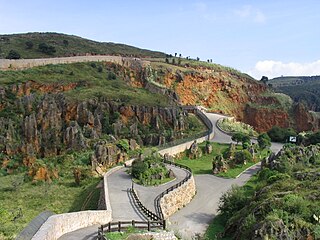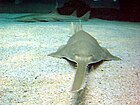Ex situ conservation literally means, "off-site conservation". It is the process of protecting an endangered species, variety or breed, of plant or animal outside its natural habitat; for example, by removing part of the population from a threatened habitat and placing it in a new location, which may be a wild area or within the care of humans. The degree to which humans control or modify the natural dynamics of the managed population varies widely, and this may include alteration of living environments, reproductive patterns, access to resources, and protection from predation and mortality. Ex situ management can occur within or outside a species' natural geographic range. Individuals maintained ex situ exist outside an ecological niche. This means that they are not under the same selection pressures as wild populations, and they may undergo artificial selection if maintained ex situ for multiple generations.

Twycross Zoo is a medium to large zoo near Norton Juxta Twycross, Leicestershire. The zoo has the largest collection of monkeys and apes in the Western World, and in 2006 re-launched itself as "Twycross Zoo – The World Primate Centre".

Hellabrunn Zoo is a 40 hectare zoological garden in the Bavarian capital of Munich. The zoo is situated on the right bank of the river Isar, in the southern part of Munich near the quarter of Thalkirchen.

Borås Djurpark is a 40-hectare (99-acre) zoo in the northern part of central Borås, Sweden. It has about 500 animals of 80 different species. The zoo was founded in 1962 by Sigvard Berggren, who was manager until 1969.

Captive breeding is the process of maintaining plants or animals in controlled environments, such as wildlife reserves, zoos, botanic gardens, and other conservation facilities. It is sometimes employed to help species that are being threatened by human activities such as habitat loss, fragmentation, over hunting or fishing, pollution, predation, disease, and parasitism. In some cases a captive breeding program can save a species from extinction, but for success, breeders must consider many factors—including genetic, ecological, behavioral, and ethical issues. Most successful attempts involve the cooperation and coordination of many institutions.

La Palmyre Zoo is a zoo in Les Mathes, Charente-Maritime, near Royan, in southwestern France. It was created in 1966 in the forest of la Coubre by Claude Caillé. Extending over 18 hectares, including 14 of landscape garden, it offers the visitor the opportunity of observing more than 1600 animals of all kinds, divided into 145 species, over a distance of more than 4 kilometres (2.5 mi).

The Zoological Center Tel Aviv-Ramat Gan in the Tel Aviv District of Israel is the largest collection of wildlife in human care in the Middle East. The 250-acre site consists of both a drive-through African safari area and a modern outdoor zoo. The African animal park opened to the general public in 1974. In 1981, the zoo was established in the middle of the park to replace the Tel Aviv Zoo, which had closed down.

Paignton Zoo, is a zoo in Paignton, Devon, England. The zoo is part of South West Environmental Parks Ltd which is owned by Wild Planet Trust, formerly known as the Whitley Wildlife Conservation Trust (WWCT). Wild Planet Trust also runs Living Coasts in Torquay, Devon and Newquay Zoo in Newquay, Cornwall. All three are registered charities.

The European Association of Zoos and Aquaria (EAZA) is an organisation for the European zoo and aquarium community that links over 340 member organizations in 41 countries. It operates the European Endangered Species Programme (EEP). The organisation is based in Amsterdam, Netherlands.

The World Association of Zoos and Aquariums (WAZA) is the "umbrella" organization for the world zoo and aquarium community. Its mission is to provide leadership and support for zoos, aquariums, and partner organizations of the world in animal care and welfare, conservation of biodiversity, environmental education and global sustainability.

The American Species Survival Plan or SSP program was developed in 1981 by the (American) Association of Zoos and Aquariums to help ensure the survival of selected species in zoos and aquariums, most of which are threatened or endangered in the wild.

The Tierpark Berlin is one of two zoos located in Berlin, Germany. It was founded in 1955 and is located in Friedrichsfelde on the former grounds of Friedrichsfelde Palace, which is situated within the zoo. As of 31 December 2013, the zoo houses 7,250 animals from 846 species, in an area of 160 hectares. Tierpark Berlin also features two public exhibits free of charge, one being the Bärenschaufenster for American black bears.
Genetic erosion is a process where the limited gene pool of an endangered species diminishes even more when reproductive individuals die off before reproducing with others in their endangered low population. The term is sometimes used in a narrow sense, such as when describing the loss of particular alleles or genes, as well as being used more broadly, as when referring to the loss of a phenotype or whole species.

Species360 founded in 1974, is an international non-profit organization that maintains an online database of wild animals under human care. As of 2016, the organization serves more than 1,000 zoos, aquariums and zoological associations in 90 countries worldwide. The organization provides its members with zoological data collection and management software called ZIMS—the Zoological Information Management System.

Ree Park – Ebeltoft Safari is a safari park in Djursland on the peninsula of Jutland, Denmark. The safari park is the home of more than 800 animals of 80 species from 5 different continents. This popular tourist attraction offers its guests a comprehensive insight in the life and behaviour of animals from Europe, Africa, North America, South America and Asia.

The breeding programs at Zoo Basel have had many highlights since the zoo's opening in 1874. These include the worldwide first zoo births of an Indian rhinoceros and greater flamingo hatch, as well as the first European gorilla birth. Due to Zoo Basel's successful breeding programs, it manages the international studbook for the Indian rhinoceros and the pygmy hippopotamus, as well as several European studbooks.

Korkeasaari Zoo is the largest zoo in Finland, located on the island of Korkeasaari in Helsinki. The zoo was first opened in 1889, originally showcasing common animals from Finland.

Zodiac Zoos is a Dutch corporation that owns and operates Aqua Zoo Friesland, Zoo Wissel, Zoo Labyrinth Boekelo, Zoo Park Overloon, and Castle Arcen.

Cabárceno Natural Park is a zoo located in a former iron mine in the town of Cabárceno, 17 kilometres (11 mi) south from Santander. The park belongs to Cantur, a company whose purpose is the promotion of tourism and which is owned by the Government of Cantabria.

Marius was a young male giraffe living at Copenhagen Zoo. Though healthy, he was genetically unsuitable for future breeding, as his genes were overrepresented in the captive population, so it was decided by the zoo authorities to kill him. Despite several offers to adopt Marius, which went against zoo policy of selling to private owners, and an online petition to save him, he was killed on 9 February 2014. His body was then dissected and necropsied in a public educational class and he was then fed to the zoo's lions. The event received worldwide media coverage and generated responses from several organisations and individuals, including death threats to staff at the zoo.




















